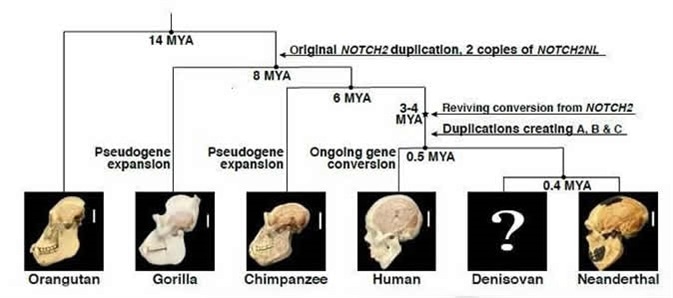NOTCH2NL refers to Notch homolog 2 N-terminal-like protein, which is involved in the Notch signaling pathway. It is implicated in the determination of the brain size in humans.
The Notch Pathway
The Notch signaling pathway is present in most multicellular organisms, where it regulates several critical developmental pathways. There are four notch receptors in mammals: NOTCH1, NOTCH2, NOTCH3, and NOTCH4. Notch receptors are transmembrane receptors, and the notch ligand binds to the extracellular domain. This leads to the cleavage and activation of the intracellular domain. The intracellular domain then enters the nucleus to regulate gene expression.
As the receptor is activated by cell-cell contact, it has important functions in cell-cell communication and cell lineage specification. Notch signaling has been shown to promote self-renewal and inhibit the process of differentiation in mouse and human cortical stem cells.
New Genetic Clues to the Mystery of Your Giant Brain
NOTCH2NL and the Notch Pathway
Recently, it was shown that NOTCH2NL can increase the expression of Hes1, a downstream effector of the Notch pathway. The effect of NOTCH2NL was also tested using a Notch activity transcriptional reporter, and it was found that the reporter activity increased in response to the NOTCH2NL gene. These results show that NOTCH2NL can directly activate the Notch pathway.

Evolutionary history of NOTCH2NL genes in the great ape lineage. Image Credit: Fiddes et al./Cell DOI: 10.1016/j.cell.2018.03.051
NOTCH2NL Expression in the Brain
NOTCH2NL gene expression has been observed in the ventricular zone of the brain, which consists of neural stem cells in the brain cortex. It consists of three paralogs: NOTCH2NLA, NOTCH2NLB, and NOTCH2NLC. NOTCH2NLA and NOTCH2NLB are expressed at low levels at gestation weeks 7−9 in mice, and the expression subsequently increases at gestation week 21. NOTCH2NLC was expressed at very low levels throughout the process of corticogenesis, or brain development. NOTCH2NL genes were found to be present throughout the ventricular zone in a salt and pepper manner at nine weeks of gestation. At later stages, they were present throughout the subventricular zone in the brain.
NOTCH2NLB Increases the Neuronal Stem Cells in the Brain
A recent study by Vanderhaeghen and co. showed that when NOTCH2NLB is activated in a subset of neural stem cells, they almost triple in number. This suggests that NOTCH2NLB is involved in the proliferation of neural progenitor cells. Similarly, the increase in progenitors was also accompanied by an increase in the number of neurons.
Role of NOTCH2NLB in Increasing Brain Size
Also, expression of NOTCH2NLB almost tripled the size of brain regions in vitro, while deletion led to smaller sized organoid tissues reinforcing the role of this gene to control neurogenesis.
NOTCH2NLB and Cell-Cycle Progression
The study above also examined the specific effects of NOTCH2NLB on the cell-cycle in neural stem cells, and the researchers found that cells expressing NOTCH2NLB showed reduced cell-cycle exit. Thus, there was an increase in cell-cycle re-entry. The NOTCH2NLB gene, therefore, can increase the neural stem cell population by increasing cell-cycle re-entry.
Evolutionary Role of NOTCH2NLB
One of the most important features different between humans and primates is our large brains. This feature led to our increased cognitive functions. The recent studies hypothesize that NOTCH2NL genes were present in the last common ancestor of humans, chimpanzees and gorillas.
However, in humans this was converted to a viable gene. This occurred when the one NOTCH2NL copy was duplicated in ancestral humans, which restored the function. The functional gene was then copied again twice to give rise to the paralogues.
This then subsequently regulated the process of neurogenesis which led to increased brain size in humans. Gorillas and chimpanzees also contain NOTCH2NL-like genes; however they are present in the form of pseudogenes, which code for non-functional proteins.
Interestingly, NOTCH2NL is located in a part of the human chromosomes which has been implicated in ADHD, autism, schizophrenia and learning disabilities. With NOTCH2NL having three paralogues, it is prone to be copied (duplicated) or lost when DNA is being replicated. When the study by Fiddes and co. looked at patients with errors around this region, it was found that duplications of NOTCH2NL lead to an increased brain size, while deletions lead to a reduction in brain size. This gives further proof that NOTCH2NL is implicated in brain size in humans.
Further Reading